|
Bindings:
NNN and SNS are the most popular for classic touring and skating.
Depending on who you talk to 75 mm or NNN-BC (Back Country) bindings will be recommended for back country skis. See below.
75 mm bindings are standard for telemark.
Back Country:
Cunningham's Ski Barn in LakePlacid says NNN boots have more torsional stability.
This makes sense because the forward flex is in the binding not the boot, so the boot can be more rigid.
Note: BC NNN bindings and WILL NOT FIT regular NNN bindings.
Others like 75 mm because it gives a more secure boot to ski connection. Heel cables can be added to some. Others come with a heel cable and no pins. Tele boots are usually 75 mm and work with 3-pin clamp down or heel cable bindings.
 Three-pin bindings (Nordic Norm) or 75mm (75-millimeter)- Older style. Three holes in boots fit into three pins in the toe plate and is clamped in place. Used by backcountry and Telemarking enthusiasts. With or without a heel cable.
Three-pin bindings (Nordic Norm) or 75mm (75-millimeter)- Older style. Three holes in boots fit into three pins in the toe plate and is clamped in place. Used by backcountry and Telemarking enthusiasts. With or without a heel cable.
With a cable pins are frequently omitted.
Some 3-pin bindings have the option of add or removing a cable.
It can handle rougher treatment and is more easily repaired in the field. The boots are usually heavier:
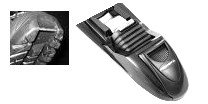 New Nordic Norm (NNN) - Rossignol, Madshus and Fischer. They are the most Popular a/o 2010
New Nordic Norm (NNN) - Rossignol, Madshus and Fischer. They are the most Popular a/o 2010
A short, metal rod mounted in the toe of the ski boot sole clips into a matching ski binding. NNN bindings feature two raised ridges on the ski's surface, which fit into matching grooves in the soles of compatible ski boots.
NNN-II or NNN-2, introduced in 1990 moved the pivot point 10 mm backward.
NNN-BC - are a heavier duty (wider [56 mm]- larger bar) version of the NNN which will not work with the basic NNN.
The heel area is flat, which increases stability when used outside groomed trails, in deep snow and with a heavy back pack.
NNN R3 Skate - Is a version for skating.
NNN BC Magnum is 67 mm wide.
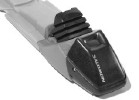 Salomon Nordic System (SNS) - Salomon and Atomic
Salomon Nordic System (SNS) - Salomon and Atomic
Similar to NNN a metal rod mounted in the toe of the ski boot clips into the binding. SNS have one grove in the boot.
- Nordic Integrated System (NIS) - The bindings attach via a mounting plate that slides onto the side rails which are an integral part of the ski designed for NIS.
R4 NIS bindings are made by Rottefella and Rossignol. These bindings are compatible with any NNN boot, but can only be used on skis that come with the permanently bonded plate, presently made only by Rossignol, Madshus, and Fischer.
- Salomon Nordic System Pilot - Used mostly by elite skiers.
- Alpine touring (AT), or randonée, requires bindings that allow a mix of backcountry, free-heeled climbing and fixed-heel alpine descents. AT skis let you hit the steep and deep without having to learn the telemark turn to safely get down the mountain.
 Telemark - Most bindings now have a stainless steel toe piece that is stamped into shape to accept the duck bill of a tele boot. The boot is then secured to the toe piece via a lever and a spring loaded cable system that clamps over the heel of the boot. Many include climbing risers to raise the heel when climbing.
Telemark - Most bindings now have a stainless steel toe piece that is stamped into shape to accept the duck bill of a tele boot. The boot is then secured to the toe piece via a lever and a spring loaded cable system that clamps over the heel of the boot. Many include climbing risers to raise the heel when climbing.
Salomon and NNN both offer heavy "back-country" versions of their system bindings. These aren't the most durable for real expeditions into the wild, but they make an excellent match for heavier touring skis for snow machine trails and groomed areas.
Boots:
For occasional off-track touring or striding on hard-packed trails and roads, you'll need boots that can handle occasional edging, turning and stopping in more variable snow conditions. Stick with lightweight boots (remember--you still want to maximize efficient forward glide), but opt for a little more ankle support and torsional rigidity.
Telemark boots are more rigid. Advanced boots look like alpine ski boots.
>
Touring boots go from $60-$160, Back country boots go from $100-$280

Poles:
Poles can range in price from $20 (Aluminum)- $200 or more for (Carbon nanoparticle).
100% carbon, composite, or aluminum? Cork grips or plastic grips? Velcro race straps or loop straps? Rubber tips, ice spikes?
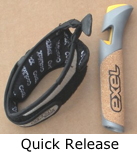
The Swix Triac 2.0, IPM (Internal Pressure Molding) carbon composite is $400.
Aluminum poles are the least expensive
High-modulus carbon fiber and nanoparticle technology make the Exel World Cup,
Yoko 9100 and Yoko 8100 race poles
6% lighter and 30% stiffer than other 100% carbon poles.
The rule of thumb is larger baskets are for deeper, ungroomed snow and small baskets require groomed conditions.
See How to Buy Perfect Cross Country Ski Poles | CrossCountrySkiTechnique.com/
Nordic Skater of Vermont:
Skis:
Classical nordic skis are narrower than alpine skis and include racing, touring and back-country skis.
Telemark and AT (Alpine touring) skis are similar to alpine skis.
Cross-country skis come in waxable and waxless varieties, with the latter having fishlike scales on the base to grip the snow. Waxless skis are easy to maintain but offer less grip, making them a good choice for newbie or recreational skiers. Classic cross-country skiers generally use waxable skis because different waxes can be used to adjust grip and glide.

- Skating or racing skis are skinny, with stiff kick zones to favor fast gliding and a vigorous style.
Skating skis are shorter and generally lighter than high-performance classical skis, but not too short.
- Classic Skis
- Touring skis are wider, with softer kick zones for better stability, control and less strenuous climbing. Skis for general touring are relatively narrow, making them perfect for striding in groomed tracks and on hard-packed trails. Narrow skis produce less drag than wide ones, so they help you glide faster, cover more ground and use less energy.
They have cross-country camber, the pronounced arch in the center that is held up off the surface of the snow, and which must be weighted for the ski to get traction. This type of camber is necessary for performing the classic kick-and-glide technique.
Classic touring skis are 55 down to 44 millimeters in width.
Compact touring skis are about 60 or 65 millimeters at its widest
Touring skis may have double camber, which lifts wax/scales out of the snow to help glide.
- Engineered Compact Skis
are a relatively new style of classic striding ski that performs like traditional-length models, yet are significantly shorter and easier to handle. This decrease in length can translate into a quicker learning curve for beginners and more fun out on the trails for anyone looking to try something new. These skis tend to be wider and have more sidecut than traditional striding skis as a result of the unique construction techniques used to build them. These features make engineered compact skis perfect for occasional backcountry exploration.
-
Back-country skis are even wider, often too wide to fit in groomed tracks. They usually have a more pronounced shape, for better turning, and metal edges to provide more security on hard-packed and icy downhills.
They should have at least a 50 mm waist, but the trend is toward wider skis with 60-68 mm waists.
Ski selection criteria:
- Laser etched rather than molded scales give better grip.
- Some skis have two scale patterns a more agressive one under food and less agressive one in transition zones.
- Double camber (more bow), alternatively termed "nordic camber" and "camber-and-a-half." is used your mostly for overland travel and single camber skis are used in the backcountry skiing for downhill runs. Heavier people will want more camber and/or a stiffer flex.
- Metal edges allow for better turning.
Metal edges at the tip and tail only allow for the scale pattern to extend to the edge of the ski.
Metal edges in the middle only allow a more flexible tip and tail.
- Wider back country skis allow for more stability and better float in untracked snow, but more resistance in groomed trails.
- More sidecut makes carving turns easier.
See:
REI: How to Choose Cross-Country Ski Touring Gear
How to Choose Cross-Country Ski Touring Gear | How to Choose Backcountry Touring Gear
Choosing a Cross Country Ski at NordicSkierSports.com
rec.skiing.backcountry FAQ -- Backcountry skis
Ski Equipment at Rocky Mountain Rambles
XC Skier's Primer
Back Country Skis:
These skis are wider and have edges. All below are waxless.
| Ski | Price | Sidecut | Weight | Features |
| Madshus Voss MGV | $200 | 60-50-55 | 1,780 | 3/4 steel edge, Positive grip 1 |
| Fischer Silent Spider | $219 | 62-52-60 | 1,890 | Mountain Edge Technology2 |
| Atomic Sierra Posi Grip | $250 | 69/56/63 | 1,780 | Positive grip 1 |
| Rossignol BC 90 Positrack | $300 | 88/60/78 | 2,100 | |
| Alpina Discovery | $209 | 68/60/65 | 2,057 | Positive grip 1 |
| Karhu XCD 10th Mountain | $309 | 99/68/84 | 2,530 | 2 scale patterns3 |
1. A waxless ski with a positive pattern of gripping teeth that lie above the metal edges to offer excellent grip that won't impede glide. .
2. Fischer Mountain Edge Technology has edges at the front and back. Pattern in kick zone extends to the edge of the ski.
3. Round, spaced scales in transition zones for glide and sharp, tight scales underfoot for grip
Telemark:
Telemarktips.com--The Telemark and Backcountry Skiing Webzine--
Telemark Skis from TELEMARKSKI.COM | telemark skiing info and gear
Climbing Skin Maintenance
Scarpa Laser AT randonnee boot modification tips tricks how to
Mounting Telemark Bindings
Maintenance:
Traditional cross country skis without a grip pattern on the bottom require two types of wax. A kick wax in the middle and glide wax on the tips and tails.
See:
Basic XC Ski Kick Wax Tutorial
Waxing Cross Country Skis for Beginners - Toko
So called Waxless or fish scale skis should still be waxed.
Use a liquid glide wax on the grip (fishscale) area. Liquid wax can be used for the glide area also or you can hot wax it.
Repair munged up holes in 3-pin boots
SmilePlates at Bluebird Day
Installation notesd
See:
Caring For Waxless Skis | CrossCountrySkier.com
video - Beverley & Saul Goldman
What is the cork for?
Waxing Corks can be very handy problem solvers as well as inexpensive iron alternatives. In emergency situations (i.e. forgetting to wax, or missing the temperature all together) corks can buff a quick layer of wax onto a ski or snowboard base. The friction between the ski and cork will heat most waxes to a point that they can be absorbed into the p-tex material. This style of application works well in the short term but given a half to a full day of skiing the coat corked into the base will no longer exist. Corks are also commonly seen on the race hill for last minute application of pure fluorocarbon powders that only last a few runs and need to be applied right before a race run.
Source: www.skis.com
Links:
Wikipedia
REI: How to Choose Cross-Country Ski Touring Gear
How to Choose Cross-Country Ski Touring Gear | How to Choose Backcountry Touring Gear
Choosing a Cross Country Ski at NordicSkierSports.com
rec.skiing.backcountry FAQ -- Backcountry skis
rec.skiing.nordic
rec.skiing.backcountry
SkinnySkis.com/
Telemark Bindings
ORSCrossCountryskisdirect.com
last updated 22 Feb 2010
|
 Sports
Sports
 Skiing
Skiing
 Cross Country Skiing - XC
Cross Country Skiing - XC
 Sports
Sports
 Skiing
Skiing
 Cross Country Skiing - XC
Cross Country Skiing - XC
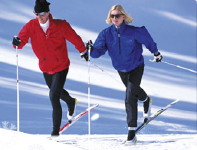
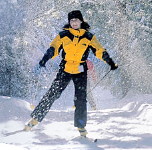 Free/Skating - Skate skiing involves the skier pushing one ski outward with the ski angled, so that the inner edge of the ski is driven against the snow, much like an ice skater.
Free/Skating - Skate skiing involves the skier pushing one ski outward with the ski angled, so that the inner edge of the ski is driven against the snow, much like an ice skater.
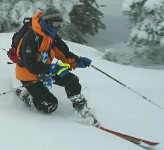 Telemark - A technique for descending used primairly in back country, but also in alpine/downhill areas. Uses wider skis with metal edges (downhill skis can be fitted with telemark bindings. Most have smooth bottoms and climbing skins are used for assents, but some may have a pattern under the boot (kick zone) for traction.
Telemark - A technique for descending used primairly in back country, but also in alpine/downhill areas. Uses wider skis with metal edges (downhill skis can be fitted with telemark bindings. Most have smooth bottoms and climbing skins are used for assents, but some may have a pattern under the boot (kick zone) for traction.
